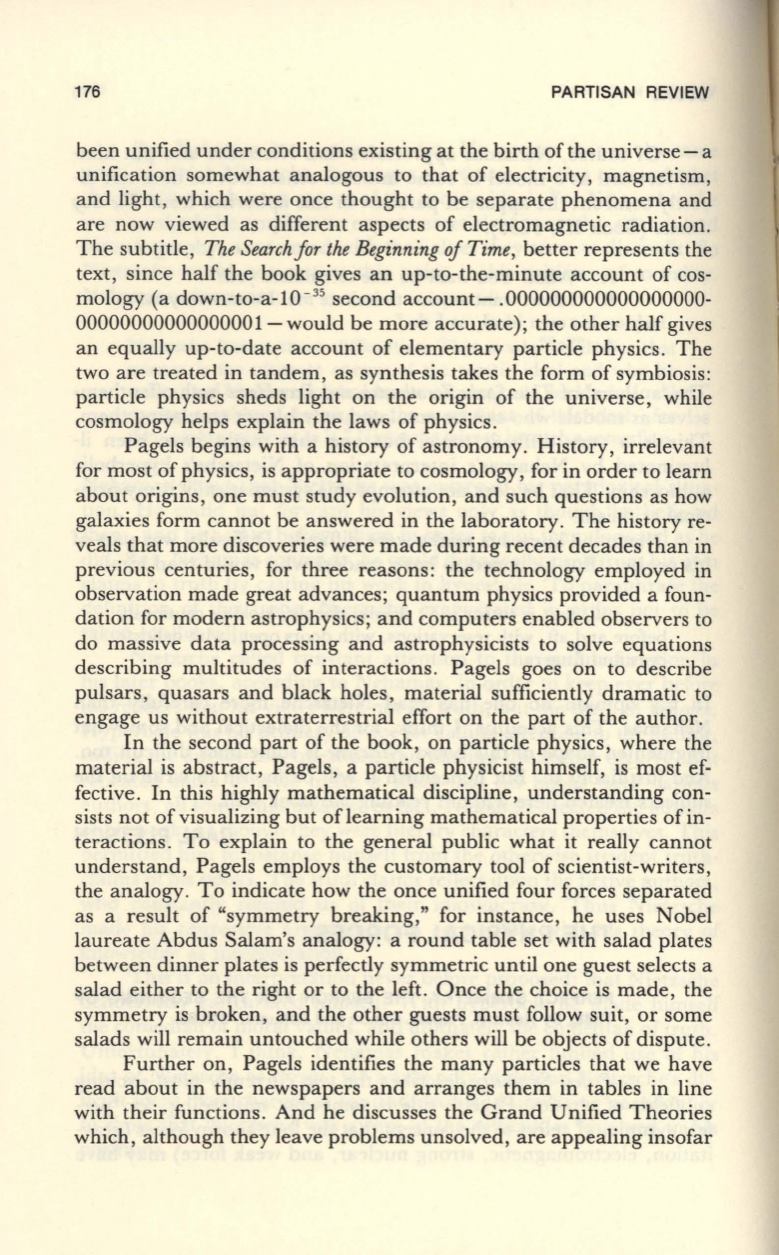
176
PARTISAN REVIEW
been unified under conditions existing at the birth of the universe - a
unification somewhat analogous to that of electricity, magnetism,
and light, which were once thought to be separate phenomena and
are now viewed as different aspects of electromagnetic radiation.
The subtitle,
The Search for the Beginning
of
Time,
better represents the
text, since half the book gives an up-to-the-minute account of cos–
mology (a down-to-a-1O -
35
second account- .000000000000000000-
00000000000000001 - would be more accurate); the other half gives
an equally up-to-date account of elementary particle physics. The
two are treated in tandem, as synthesis takes the form of symbiosis:
particle physics sheds light on the origin of the universe, while
cosmology helps explain the laws of physics.
Pagels begins with a history of astronomy . History, irrelevant
for most of physics, is appropriate to cosmology, for in order to learn
about origins, one must study evolution, and such questions as how
galaxies form cannot be answered in the laboratory. The history re–
veals that more discoveries were made during recent decades than in
previous centuries, for three reasons: the technology employed in
observation made great advances; quantum physics provided a foun–
dation for modern astrophysics; and computers enabled observers to
do massive data processing and astrophysicists to solve equations
describing multitudes of interactions. Pagels goes on to describe
pulsars, quasars and black holes, material sufficiently dramatic to
engage us without extraterrestrial effort on the part of the author.
In the second part of the book, on particle physics, where the
material is abstract, Pagels, a particle physicist himself, is most ef–
fective. In this highly mathematical discipline, understanding con–
sists not of visualizing but of learning mathematical properties of in–
teractions . To explain to the general public what it really cannot
understand, Pagels employs the customary tool of scientist-writers,
the analogy. To indicate how the once unified four forces separated
as a result of "symmetry breaking," for instance, he uses Nobel
laureate Abdus Salam's analogy: a round table set with salad plates
between dinner plates is perfectly symmetric until one guest selects a
salad either to the right or to the left. Once the choice is made, the
symmetry is broken, and the other guests must follow suit, or some
salads will remain untouched while others will be objects of dispute.
Further on, Pagels identifies the many particles that we have
read about in the newspapers and arranges them in tables in line
with their functions. And he discusses the Grand Unified Theories
which, although they leave problems unsolved, are appealing insofar


